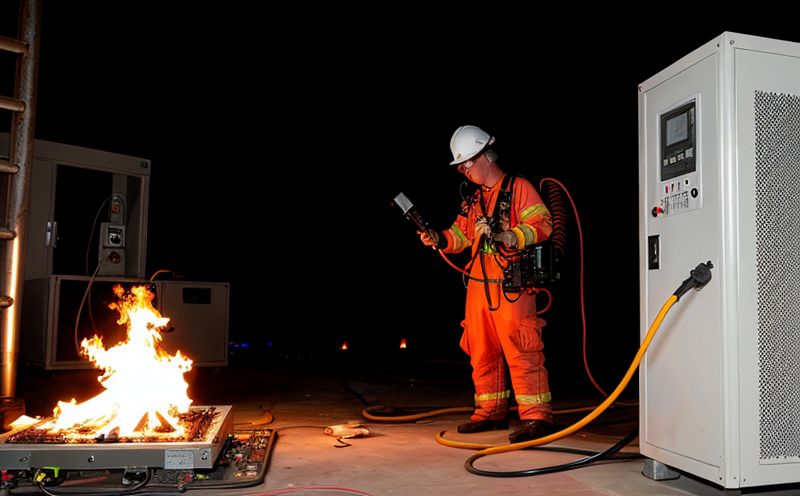Fire Behavior Testing of Insulating Materials
The fire behavior testing of insulating materials is a critical process in ensuring the safety and compliance of electrical and electronic equipment across various sectors. This service involves rigorous assessment to determine how insulating materials behave under heat, flame, or other forms of thermal stress. Fire behavior testing goes beyond mere flammability; it evaluates factors such as smoke production, heat release rate, and the overall resistance of materials against combustion.
The importance of this testing cannot be overstated, especially in high-risk environments like data centers, hospitals, and aerospace facilities where even minor errors could lead to catastrophic consequences. By understanding how insulating materials perform under fire conditions, manufacturers can make informed decisions about material selection and product design that enhance safety without compromising performance.
The testing process typically begins with the preparation of specimens according to strict standards such as ASTM E648 or ISO 5267. These specimens are then subjected to controlled environments where they are exposed to various types of ignition sources, including burners, hot wire testers, and radiant heat devices. The behavior of these materials is continuously monitored using advanced instrumentation like thermopile sensors, carbon monoxide detectors, and smoke measurement instruments.
One key aspect of fire behavior testing is the calculation of the Heat Release Rate (HRR), which quantifies the amount of heat released by a material over time. This metric is crucial for assessing the potential impact on nearby structures or personnel in case of a fire event. Additionally, the smoke density and toxicity are also measured to ensure that materials do not release excessive amounts of harmful gases during combustion.
Another important parameter is the UL 746C Flame Spread Index (FSI), which provides information about how quickly flames spread across a surface. A lower FSI indicates better flame resistance, making it an essential factor in selecting appropriate materials for critical applications. Furthermore, the vertical burn test (ASTM E1350) simulates real-world conditions by subjecting specimens to controlled burns from below, thereby providing valuable insights into their performance.
| Standard | Description |
|---|---|
| ASTM E648-19 | Determines the limiting oxygen index of materials, indicating how much air is needed to sustain combustion. |
| ISO 5267-1:2015 | Describes the procedures for measuring heat release rate and other fire-related properties using a cone calorimeter. |
| UL 94 | Evaluates flammability characteristics of plastic materials used in electronic equipment. |
Applied Standards
- ASTM E648-19: This standard determines the limiting oxygen index of materials, indicating how much air is needed to sustain combustion. It helps in identifying materials that are inherently more resistant to ignition.
- ISO 5267-1:2015: Describes the procedures for measuring heat release rate and other fire-related properties using a cone calorimeter. This method is particularly useful for evaluating the thermal stability of insulating materials under fire conditions.
- UL 94: Evaluates flammability characteristics of plastic materials used in electronic equipment, providing grades that indicate relative flame resistance.
International Acceptance and Recognition
The results from fire behavior testing are widely recognized by regulatory bodies around the world, including those in Europe (such as the European Union's Low Voltage Directive), North America (like UL 94), and Asia-Pacific regions. Compliance with these standards not only ensures product safety but also facilitates market access to international markets.
For example, materials that pass rigorous testing according to ASTM E648 or ISO 5267 gain certification from organizations like Underwriters Laboratories (UL) and Intertek. These certifications are highly valued by manufacturers and buyers alike as they signify adherence to stringent safety protocols. Moreover, many leading companies in the semiconductor industry rely on these tests to meet customer specifications and ensure compliance with industry standards.
The global acceptance of fire behavior testing underscores its significance in safeguarding public health and property across diverse industries ranging from consumer electronics to industrial automation systems. By adhering to these internationally recognized practices, laboratories can provide reliable data that instills confidence among stakeholders involved in the design, manufacturing, and deployment of electrical and electronic equipment.
Environmental and Sustainability Contributions
- Reduced Fire Hazards: By identifying materials with superior fire resistance early in the development process, this testing helps minimize risks associated with electrical fires.
- Innovation in Material Science: Encourages research into safer and more sustainable alternatives for traditional insulating materials.
- Cost Savings: Early identification of non-compliant materials can prevent costly rework or product recalls later down the line.
- Eco-friendly Solutions: Promotes the development of fire-resistant materials that are less toxic and produce fewer harmful emissions when exposed to flames.





